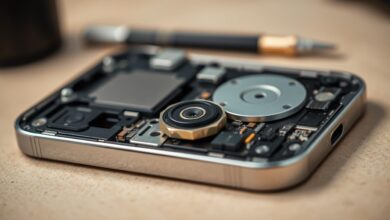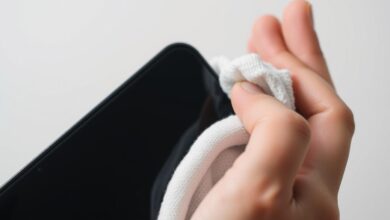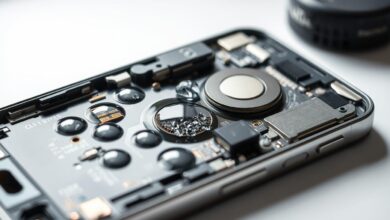how to clean iphone speakers
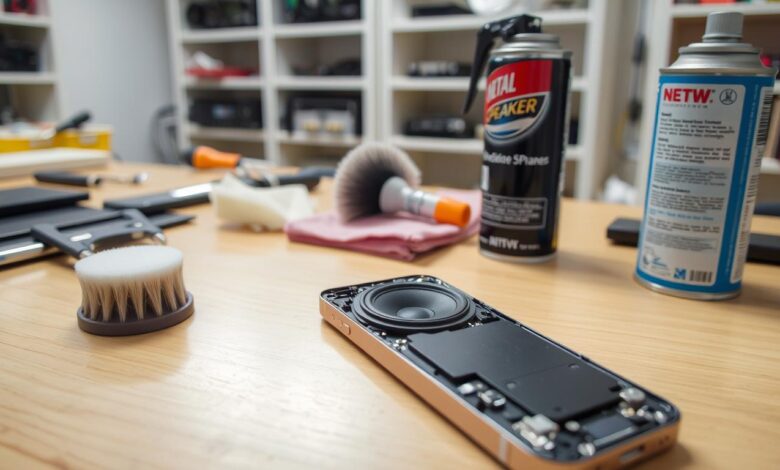
Is your iPhone’s sound quality not as clear as it used to be? Dust and debris can build up in the speakers, making the sound worse. It’s important to clean them regularly to keep the sound quality high.
I’ll show you a simple, effective way to get your device’s sound back to normal. By following these steps, you can enjoy clear, crisp audio again.
Cleaning your iPhone speakers is easy and safe if you follow the right steps. This guide will help you clean your device safely and effectively.
Key Takeaways
- Understand the importance of regular iPhone speaker cleaning
- Learn a simple, step-by-step DIY cleaning process
- Discover tips for maintaining optimal audio quality
- Ensure safe and effective cleaning methods
- Improve your iPhone’s overall performance
Why Clean iPhone Speakers Regularly
Keeping your iPhone’s sound quality up means cleaning its speakers often. Dirt and debris can build up and really mess with how it sounds.
Impact of Dirt and Debris on Audio Quality
Dirt and debris can make your iPhone’s sound muffled. This can lead to a drop in sound quality. When dust or other particles block the speaker grills, it can cause distortion or lower the volume. Cleaning them regularly helps keep your iPhone’s sound clear and crisp.
Signs Your iPhone Speakers Need Cleaning
If you notice any of these problems, it’s time to clean your iPhone speakers:
- Muffled or distorted sound
- Low volume or quiet speakers
- Crackling or buzzing noises
These signs often mean your speakers are dirty. Regularly checking and cleaning them can help fix these issues.
Spotting the signs of dirty iPhone speakers early helps keep your device’s sound quality up. It also stops bigger problems from happening.
Understanding iPhone Speaker Design
The design of iPhone speakers is quite complex. Knowing this is important for keeping them in good shape. These speakers are made to play high-quality sound. But, their detailed design can lead to problems like debris buildup and damage.
Speaker Locations on Different iPhone Models
Speakers on iPhones are placed in different spots depending on the model. For example, older iPhones have speakers at the bottom. Newer models have them on the front or top too.
| iPhone Model | Speaker Locations |
|---|---|
| iPhone 6 and earlier | Bottom |
| iPhone 7 and later | Bottom, Front (earpiece) |
| iPhone X and later | Bottom, Front (earpiece), Top (on some models) |
Speaker Grill Construction and Vulnerabilities
The speaker grill is key to protecting the speaker inside. But, it’s also a weak spot for debris. The mesh design lets sound out but can trap dust and lint.
“The speaker grill’s mesh design is a double-edged sword; it allows for sound emission but also traps debris, potentially affecting audio quality.”
How Debris Accumulates in iPhone Speakers
Debris in iPhone speakers comes from many sources. Dust, lint, and small particles can get in through the grill. This can mess with the sound quality.
- Dust and lint from clothing or environment
- Moisture and humidity
- Exposure to dirty or dusty surfaces
Knowing these causes helps keep your iPhone speakers clean and working well.
Essential Tools for Cleaning iPhone Speakers
To clean your iPhone speakers safely, you’ll need a few key tools. The right tools help remove debris without harming your device’s speakers.
Safe Cleaning Tools I Recommend
Choosing the right tools for cleaning your iPhone speakers is key. Here are the safe cleaning tools I suggest:
- A soft-bristled toothbrush or a specialized electronics cleaning brush
- Compressed air made for electronics
- A microfiber cloth
- Adhesive tape (like Scotch tape) for removing lint and dust
These tools are gentle on your iPhone’s speakers. For example, a soft-bristled toothbrush can gently sweep away dust and dirt from the speaker grills.
Tools to Avoid When Cleaning iPhone Speakers
It’s just as crucial to know what not to use. Some tools can harm your iPhone speakers or push debris further into the grills. Avoid using:
- Sharp objects or metal tools that can scratch or puncture the speakers
- Household cleaners or chemicals that can damage the speaker components
- Excessive force or pressure that can push debris deeper into the speakers
- Cotton swabs, which can leave behind cotton fibers
By using only the recommended safe cleaning tools and avoiding harmful ones, you can clean your iPhone speakers safely.
Preparing Your iPhone for Cleaning
To clean your iPhone safely and well, you must prepare it first. This step is often missed but is very important. It helps avoid damage to your device and makes cleaning more effective.
Powering Off Your Device
The first thing to do is to power off your iPhone completely. This is a key safety step to avoid any accidental turns on or electrical shocks while cleaning. To turn off your iPhone, press and hold the sleep/wake button until you see the “Slide to Power Off” slider. Then, slide it to the right. This simple action keeps you and your device safe.
Removing Your Case and Screen Protector
Then, you need to take off any cases or screen protectors from your iPhone. These can hold onto dust and dirt, making it hard to clean the speakers. By removing them, you can clean around the speakers better. Carefully remove the case and screen protector to avoid harming your iPhone.
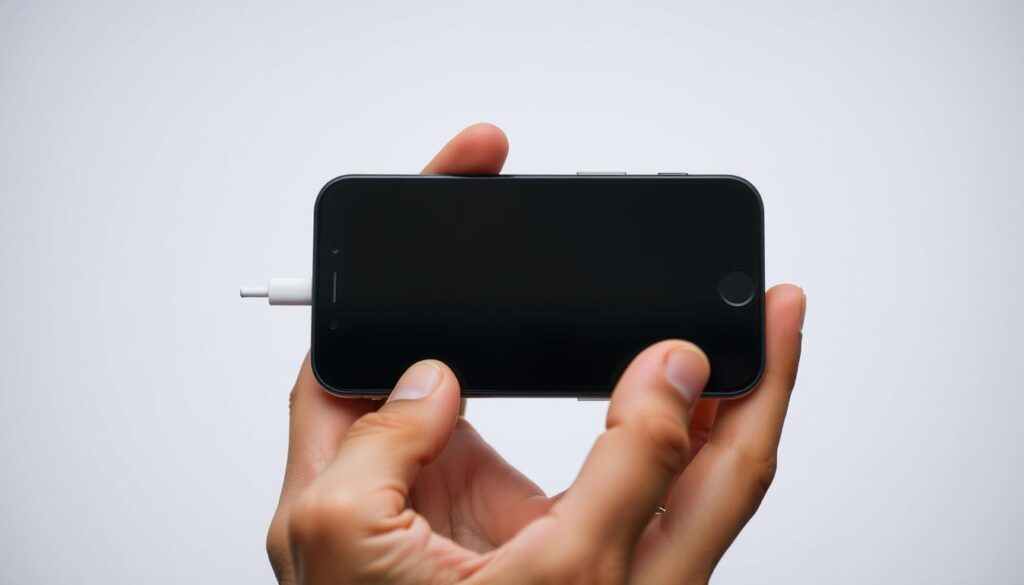
Examining Speaker Condition Before Cleaning
Before you start cleaning, take a moment to look at your iPhone speakers. Check for any dirt, dust, or debris in the speaker grills or around the speakers. This helps you know where to focus your cleaning efforts. It’s also a chance to spot any damage or wear that might need a pro’s help.
By taking these steps, you can clean your iPhone speakers safely and well. Good preparation is essential to keep your device’s sound quality and performance up.
How to Clean iPhone Speakers Without Damage
To keep your iPhone’s sound quality top-notch, cleaning the speakers regularly is key. Over time, dust, dirt, and other debris can build up and dull the sound. Luckily, there are safe and effective ways to clean your iPhone speakers without harming them.
Gentle Brushing Technique
Using a soft-bristled brush is a safe way to clean your iPhone speakers. A small, dry brush can gently remove dust and debris from the speaker grills. Make sure to use a brush made for electronics to avoid scratching your iPhone’s speakers. For more info on safe cleaning tools, check out Tom’s Guide.
Using Compressed Air Safely
Compressed air can be useful for cleaning, but use it carefully. Hold the can upright and spray short bursts from about 6 inches away. Don’t tilt the can, as it could release liquid that might harm your iPhone. Never spray compressed air directly into the speaker grille. Instead, aim for the areas around it to remove debris.
Adhesive Methods for Debris Removal
Adhesive methods, like sticky tapes or putty, can remove tough debris from iPhone speakers. Gently press the adhesive onto the speaker grill and then lift it off. This can pull out dust and dirt that other methods might miss. But be careful not to press too hard, as you don’t want to push debris further into the speaker.
Microfiber Cloth Cleaning Method
A microfiber cloth is a safe tool for cleaning your iPhone speakers. Gently wipe the speaker grills with a dry microfiber cloth to remove dust or debris. For a deeper clean, you can dampen the cloth slightly with water. But make sure it’s not too wet to avoid moisture getting into the speaker openings. Always avoid using harsh chemicals or abrasive materials that could damage your iPhone’s speakers.
By following these steps, you can clean your iPhone speakers safely. Regular cleaning will help keep your iPhone’s audio quality high.
Step-by-Step Speaker Cleaning Process
Follow a step-by-step guide to clean your iPhone speakers well. This guide will show you how to clean each part of your iPhone speakers.
Bottom Speaker Cleaning Procedure
To clean the bottom speaker, start by gently brushing away any visible debris. Use a soft-bristled brush. Be careful not to push too hard, as this could damage the speaker grill.
Next, use compressed air to blow out any remaining dust or dirt. Hold the can upright and spray the air in short bursts, about 6 inches away from the speaker.
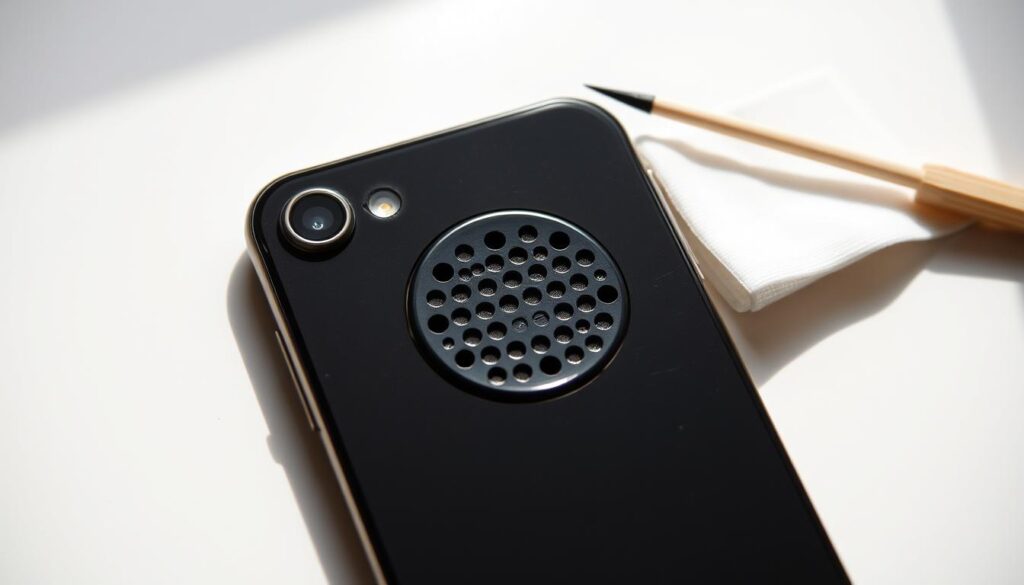
Earpiece Speaker Cleaning Technique
For the earpiece speaker, use a soft, dry cloth to wipe away any visible debris. You can also use a small, dry brush to gently sweep away dust or dirt.
Be cautious not to insert the brush too far into the speaker, as this could cause damage.
Stereo Speaker Maintenance (iPhone 7 and Later)
For iPhone 7 and later models, the stereo speakers require special attention. Use the same brushing and compressed air techniques as for the bottom speaker.
| Speaker Type | Cleaning Method | Precautions |
|---|---|---|
| Bottom Speaker | Brushing, Compressed Air | Avoid pushing too hard |
| Earpiece Speaker | Soft Cloth, Dry Brush | Don’t insert brush too far |
| Stereo Speakers (iPhone 7+) | Brushing, Compressed Air | Be gentle to avoid damage |
By following these steps, you can effectively clean your iPhone speakers and maintain their performance.
Advanced Cleaning Methods for Stubborn Debris
Standard cleaning methods might not work for all debris. For iPhone speakers with tough clogs, try more advanced techniques. These can make a big difference.
Advanced cleaning methods tackle tough debris. They use isopropyl alcohol and sonic cleaning.
Using Isopropyl Alcohol Safely
Isopropyl alcohol can clean iPhone speakers well. But, use it safely to protect your device. Dampen a cotton swab with alcohol, but don’t soak it. Gently rub the swab on the speaker grill, avoiding sensitive areas.
Apple warns against liquids near electronics. “Isopropyl alcohol can harm materials,” says an expert. Test it on a small area first. If done right, it can clear stubborn grime.
Sonic Cleaning Techniques
Sonic cleaning uses sound waves to remove debris. Apps and devices are made for this. They emit sound frequencies to dislodge particles.
To sonic clean, download a sound frequency app or use a device. Follow the instructions to create the right sound waves. This method is great for deep-seated debris.
These advanced cleaning methods can improve your iPhone’s speaker. But, be careful, especially with isopropyl alcohol and sonic cleaning.
Cleaning iPhone Speaker Grills Effectively
Cleaning your iPhone’s speaker grills is key to keeping sound quality high. These grills can get clogged with dust, lint, and other stuff. This can really mess up how your iPhone sounds.
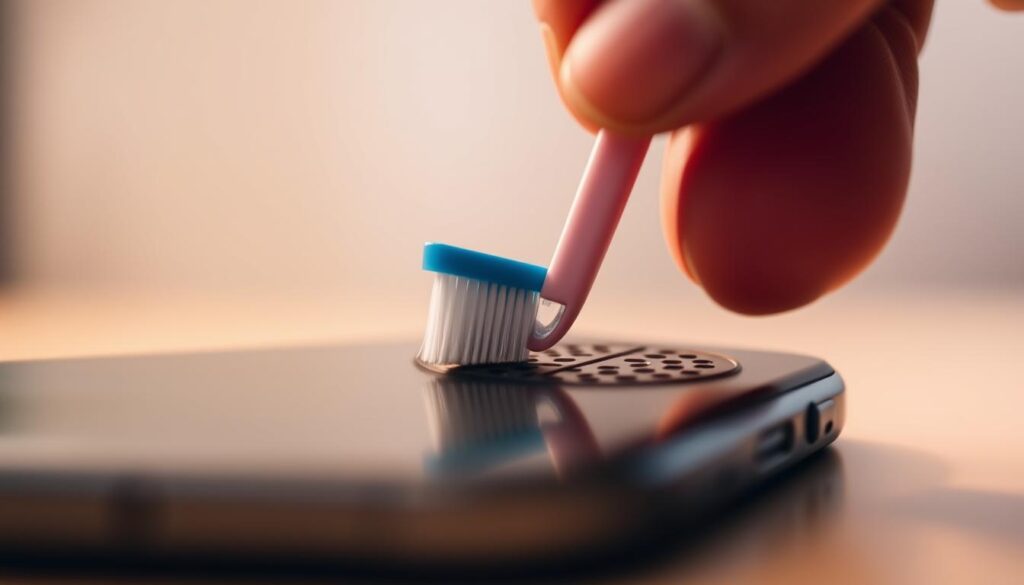
It’s important to know how to clean these grills right. Doing this regularly stops debris from building up. This keeps your iPhone’s speakers working well.
Removing Lint and Dust from Speaker Holes
One way to clean speaker grills is to gently remove dust and lint. Use a soft-bristled brush or a special cleaning tool for this. For tough stuff, compressed air works well, but use it carefully to avoid pushing dirt deeper.
For more tips on cleaning your iPhone speakers, check out this article.
Addressing Liquid Damage in Speaker Grills
Dealing with liquid damage is urgent. If your iPhone gets wet, dry it off quickly with a microfiber cloth. Don’t use heat to dry it out. Sometimes, you might need a pro to fix it.
To avoid water damage, use protective cases and be careful around liquids. Also, check your iPhone for moisture signs often. This helps catch problems early.
Common Mistakes to Avoid When Cleaning iPhone Speakers
Cleaning your iPhone speakers is crucial for good sound quality. It’s a delicate task that needs care and precision. We’ll look at common mistakes and how to avoid them to keep your speakers working well.
Harmful Cleaning Agents
Wrong cleaning agents can harm your iPhone speakers. Avoid harsh chemicals like bleach or ammonia. They can damage the speakers. Use gentle methods or special cleaning solutions instead.
Excessive Pressure and Physical Damage
Too much pressure or the wrong tools can damage speakers. Clean gently and avoid sharp objects that could harm the grills.
Moisture-Related Risks
Moisture is a big risk when cleaning speakers. Don’t use wet cloths or let the speakers get too wet. This can cause damage or corrosion.
| Mistake | Potential Damage | Prevention Method |
|---|---|---|
| Using Harsh Chemicals | Corrosion of speaker components | Use gentle, specifically designed cleaning solutions |
| Applying Excessive Pressure | Physical damage to speaker grills or components | Clean gently with appropriate tools |
| Exposing to Moisture | Damage or corrosion over time | Avoid wet cloths and excessive humidity |
The key to maintaining your iPhone’s speakers is gentle, informed care.
Knowing these common mistakes and how to avoid them can help your iPhone speakers last longer. This keeps your audio quality high.
Preventative Maintenance for iPhone Speakers
Keeping your iPhone speakers working well is easier than you think. A few simple steps can help avoid damage and keep sound quality high.
Protective Cases That Minimize Debris
Using a quality protective case is a smart move. It keeps dust and dirt out of your speakers. Choose a case that covers the speakers or has a design that blocks debris. For more tips, check out iPhone maintenance tips.
Key Features to Look for in a Protective Case:
- Covered or protected speaker grills
- Durable material that resists wear and tear
- Snug fit to prevent dust accumulation
Environmental Considerations
Things like dust, moisture, and extreme temperatures can harm your speakers. Try to use your iPhone in clean, dry places. Keep it away from direct sunlight and cold.
Tips for Environmental Protection:
- Avoid using your iPhone near water or in humid conditions
- Keep your iPhone away from dusty environments
- Avoid leaving your iPhone in a hot car or direct sunlight
Regular Maintenance Schedule
Having a regular maintenance plan is key. This includes cleaning, checking for debris, and updating your software.
| Maintenance Task | Frequency | Notes |
|---|---|---|
| Inspect Speaker Grills | Weekly | Check for visible debris or blockages |
| Clean Speakers | Monthly | Use gentle cleaning methods as described in previous sections |
| Software Updates | As Available | Regularly update your iPhone’s software to ensure optimal performance |
Troubleshooting Audio Issues After Cleaning
After cleaning your iPhone speakers, you might still face audio problems. These can include volume issues or distortion. Sometimes, cleaning alone isn’t enough to fix these problems.
If you’re still having audio troubles, finding the cause is key. This section will help you with common problems and how to solve them.
Volume Problems and Solutions
Volume issues can show up in different ways. You might find the volume too low or unable to adjust it. Here are some steps to help:
- Check if the volume limit is enabled and adjust it if necessary.
- Ensure that the volume buttons are functioning correctly.
- Restart your iPhone to resolve any software glitches.
- If the issue persists, consider resetting your iPhone’s settings to their default values.
Resetting your iPhone’s settings can often fix volume problems. It reverts any custom settings that might be causing the issue.
Distortion Issues and Fixes
Distortion can be a big problem, often caused by debris or damage to the speaker. To fix distortion, try these steps:
- Inspect the speaker grills for any remaining debris or blockages.
- Check for any signs of water damage or corrosion.
- Try playing audio at different volumes to see if the distortion persists.
- If the distortion is present only at high volumes, it might indicate a hardware issue.
In some cases, distortion at high volumes can mean a serious problem. This could be internal speaker damage, needing professional help.
By following these steps, you can find and possibly fix common audio problems after cleaning your iPhone speakers.
When to Seek Professional Cleaning Services
If your iPhone speakers don’t work after trying different cleaning methods, it’s time to get help from experts. DIY cleaning can fix many problems. But, some issues need a professional touch to fix your device’s sound.
Signs of Internal Speaker Damage
Internal speaker damage shows in different ways. It’s not just about dirt or debris. Look out for:
- Persistent distortion or crackling sounds
- Significantly reduced volume or complete loss of sound
- Water damage indicators turning red or pink
- Physical damage to the speaker grill or surrounding area
These signs mean the problem is deeper. Ignoring these symptoms can lead to further damage, making your iPhone unusable.
Apple Support and Authorized Service Options
For internal speaker damage or ongoing audio problems, Apple Support or authorized services are your best bet. They have the skills and tools to fix complex issues.
| Service Provider | Benefits | Considerations |
|---|---|---|
| Apple Support | Official Apple resources, warranty coverage | May require shipping device, potential wait times |
| Authorized Service Providers | Convenient locations, potentially faster service | Quality can vary between providers |
Before getting professional help, check your iPhone’s warranty status and know the costs. Apple Support can help you decide the best action for your device.
My Recommended Cleaning Schedule for Optimal Audio
To keep your iPhone’s speakers in top shape, follow a regular cleaning routine. This boosts your listening experience and extends your device’s speaker life. A good cleaning schedule is crucial for the best sound quality.
Daily Usage Maintenance Tips
Be careful with your iPhone’s environment for daily care. Don’t use it in dusty or dirty places. Use a protective case that covers the speakers.
Also, wipe your iPhone’s exterior, including the speaker grills, with a soft, dry microfiber cloth. This stops debris from building up. It makes deeper cleanings less often needed.
Weekly Cleaning Routine
Weekly, do a detailed cleaning of your iPhone’s speakers. Turn off your device and remove any case or screen protector. Use a soft-bristled brush to sweep away visible debris from the speaker grills.
Then, use compressed air to get rid of dust or particles. Hold the can upright and spray short bursts, 6 inches from the speaker grills. This keeps debris from getting pushed further into the speakers.
Monthly Deep Cleaning Process
For a monthly deep clean, you’ll need more tools. First, check the speaker grills for stubborn debris. If you find any, use a sticky note or cleaning putty to remove it gently.
For a deeper clean, dampen a microfiber cloth with water or a cleaning solution for electronics. Gently wipe the speaker grills, avoiding any liquid getting into the openings.
By sticking to this cleaning schedule, you’ll keep your iPhone’s audio quality high. Regular care not only keeps your device sounding great but also prevents damage.
Conclusion
Keeping your iPhone’s sound quality high is key for a great user experience. By learning how to clean your iPhone speakers, you can make sure your device sounds its best. This guide shows you how to do it.
It’s important to clean your speakers regularly to avoid damage. I suggest setting up a cleaning routine. Use the right tools and watch out for things that might harm your speakers’ sound.
By following these tips, you’ll get clear, distortion-free sound from your iPhone. Whether you’re listening to music, watching videos, or talking on the phone, your iPhone will sound great. Cleaning and taking care of your speakers is easy and helps keep your device working well.
FAQ
How often should I clean my iPhone speakers?
Clean your iPhone speakers every few weeks. This depends on how much you use them and where you are. If sound quality drops or you see dirt, clean them right away.
Can I use a vacuum cleaner to clean my iPhone speakers?
No, don’t use a vacuum on your iPhone speakers. It can harm them or push dirt in. Instead, use compressed air or a soft brush to clean.
Is it safe to use isopropyl alcohol to clean my iPhone speakers?
Yes, but be careful with isopropyl alcohol. Dampen a microfiber cloth with a little alcohol and wipe the speakers. Don’t get liquid in the openings or use too much, as it can damage the speakers.
What are the signs that my iPhone speakers need cleaning?
Look for muffled or distorted sound, or see dust in the grills. If volume or sound quality is off, cleaning might fix it.
Can I clean my iPhone earpiece speaker the same way as the bottom speaker?
Cleaning the earpiece is similar but more careful. Use a soft brush or dry microfiber cloth. Avoid liquids and harsh chemicals.
How can I prevent debris from accumulating in my iPhone speakers?
Use a protective case and avoid dirty places. Clean your speakers regularly with the right methods.
What should I do if I’ve already damaged my iPhone speakers while cleaning?
Stop cleaning if you damage your speakers. Check the damage. If it’s minor, try a different cleaning method. For serious damage, contact Apple Support or an authorized service.
Are there any specific cleaning products designed for iPhone speakers?
There are no special products for iPhone speakers. Use a soft brush, compressed air, or microfiber cloth. Avoid harsh chemicals or abrasive materials.

